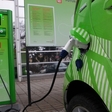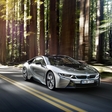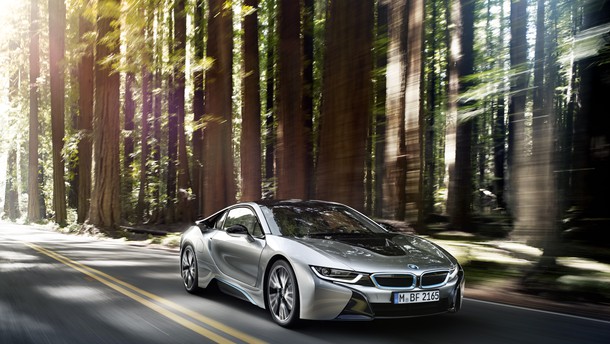
When we are talking about cars with alternative drivetrains, we usually use terms like EV, BEV, EREV, PHEV or FCEV. These actually describe the technology very accurately and, at the same time reveal, the intended use of the car.
BEV - Electric Vehicle
EV, interchangeable with BEV (Battery Electric Vehicle), is an abbreviation for the basic form of an electric vehicle that has no internal combustion engine (ICE). It is driven by an electric motor which gets energy from electricity that is stored in batteries. The most commonly-used batteries in electric vehicles are lithium-ion (Li-Ion) batteries or upgraded lithium-polymer batteries (Li-Poly).
Assisted by chargers of varying strengths (which are powered by direct or alternate currents), batteries are charged on the public electricity network, and they also gain energy by regenerative braking – the transformation of the energy of the car as it brakes, into electricity that can increase the drive range by one-fifth. The ranges of electric vehicles depend on the battery capacity, but these days most of them can carry you around 200 kilometers on a single full charge, which suffices for everyday errands.
Of course, there are also more expensive exceptions that can manage twice this range. If your daily routes range between 100 to 150 kilometers, and you can undertake longer journeys with a different car (or different kind of transport), then an EV is the right choice for you.

PHEV - Plug-in Hybrids
Plug-in hybrids are hybrid electric/gaspowered vehicles with a stronger battery. The latter can be charged from any external source of electricity, and this provides for an increased electric range, which is usually up to 50 kilometers. This is a combination of an electric and an internal combustion engine. The engine is usually gas or diesel-driven. PHEVs are usually parallel hybrids, meaning that either or both engines can drive the car, depending on the drive mode.
Due to the high torque of electric motors, the internal combustion engine mostly operates in the maximum fuel consumption zone, which is reflected in an overall lower use of fuel and lower emissions of harmful substances. The majority of current plug-in hybrids have electric motors that provide for about one-third of he total power, but the ratio is slowly turning around. A PHEV is perfect for those who travel short routes, but also many routes that exceed the capacities of an EV.

EREV - Electric Vehicles with range extender units
Electric vehicles with range extender units are also hybrids, but unlike plug-in hybrids, these are mostly series hybrids. This means that the vehicle is driven by an electric motor which is charged from batteries, and these batteries are charged by electricity from the grid. When the batteries are empty, a relatively small internal combustion engine turns on and drives an electric generator, which supplies energy to the batteries that drive the electric motors.
This is actually a battery electric vehicle, which uses a fuel engine to greatly extend its range. The range depends on the fuel tank size, but it can exceed 500 kilometers. These vehicles regenerate energy when speed is reduced. EREVs are usually chosen by those who want an EV, but are not completely convinced that the range will be sufficient, and who don't want or need a PHEV. Due to the additional engine, the EREV is more expensive than a pure electric vehicle.
FCEV - Fuel Cell Vehicles
Electric fuel cell vehicles use fuel cells to power their on-board electric motor. Fuel cells obtain electricity in a chemical manner, by separating hydrogen molecules into protons and electrons. The hydrogen protons pass through a membrane, where they bond with oxygen to form water, and the emitted electrons create an electric current that is stored in batteries and drives the vehicle's electric motor. The most commonly-used fuel in fuel cell vehicles is hydrogen or methane - their emissions are composed of a pure water steam (if methane is used, they also emit carbon dioxide), so they are completely environmentally-friendly.
They usually have a built-in battery like ordinary hybrids. The battery is intended for storing excess electricity from the fuel cell, during fast changes in driving mode. The range depends on size of the fuel tank, and can reach 400 kilometers or more, just like internal combustion engine vehicles, and filling the fuel tank doesn't take any more time. On average, a hydrogen-powered FCEV with a hydrogen drive uses approximately 1 kilogram of hydrogen per 100 kilometers.

To make a smooth transition to powering your car with electrons, there are a few things you should know and ask yourself:
Am I the electric car person?
Are you green oriented person? What type of driver are you? Do you drive the short journeys EVs can cope with? How far you typically drive each day? Do you need a lot of heat? Because the range of EV can drop due to using battery power to heat or cool the cabin. You need to care for your battery and follow the battery technology development.
Where to buy?
For all the differences between gas and electric cars, there is one which is similar: you still need to go through a sales person at a car dealership. Electric cars are sold by major car manufacturers, so when choosing your dealer, you should consider how you will get the car serviced.
Where to recharge?
Figure out your recharging options.Thinking about home recharger or will you recharge in public location? What are the costs of charge? How long does it take?
Get informed.
Before buying electric car, spend a little time on websites and get informed about costs, environmental impacts, driving range, charging and the growing list of models that are in the marketplace. And of course - give a ride first. If a smooth and silent ride put's a big smile on your face, that's it.
All guides:

Winter Driving Tips for Electric Vehicles
The winter is here. Low temperatures, snowfall, ice-cold mornings... Are you ready to drive your electric car under these conditions? Check our tips to make your electric drive as pleasant as 'dashing through the snow in a one horse open sleigh'.

Owning an electric car: pros and cons
When one is about to buy an electric car, considering the pros and the cons is vital. Electric cars have both, as any other thing, so let's take a quick look at them.

4 top things you need to know before buying a plug-in car
Before you decide to buy a new plug-in hybrid or an all-electric car, it's good to think a little bit about why you want to own this type of a car, what are its benefits, and perhaps even, if the myths about it are true?

What is an electric car and how does it work?
To put is simply, an electric car or an electric vehicle (commonly abbreviated as EV) is a car that is powered exclusively by an electric motor instead of a conventional gasoline engine.

When you have to choose - a short guide to the world of electricity vehicles
Are you thinking about buying a more eco-friendly vehicle? Would you like to have an electric car or plug-in hybrid, but you're not sure which would be more appropriate for you, or what all the weird abbreviations mean? We have…

